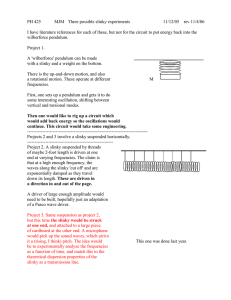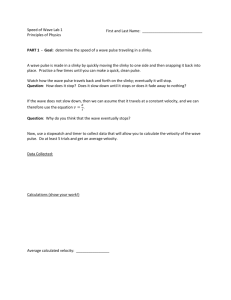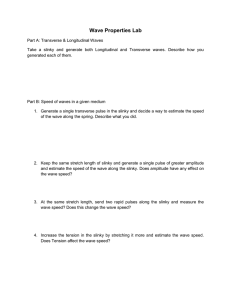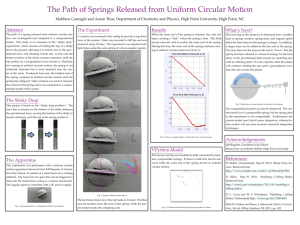The purpose of today’s lab is to explore the relationship... waves and the properties of the materials they travel through... 12.001
advertisement
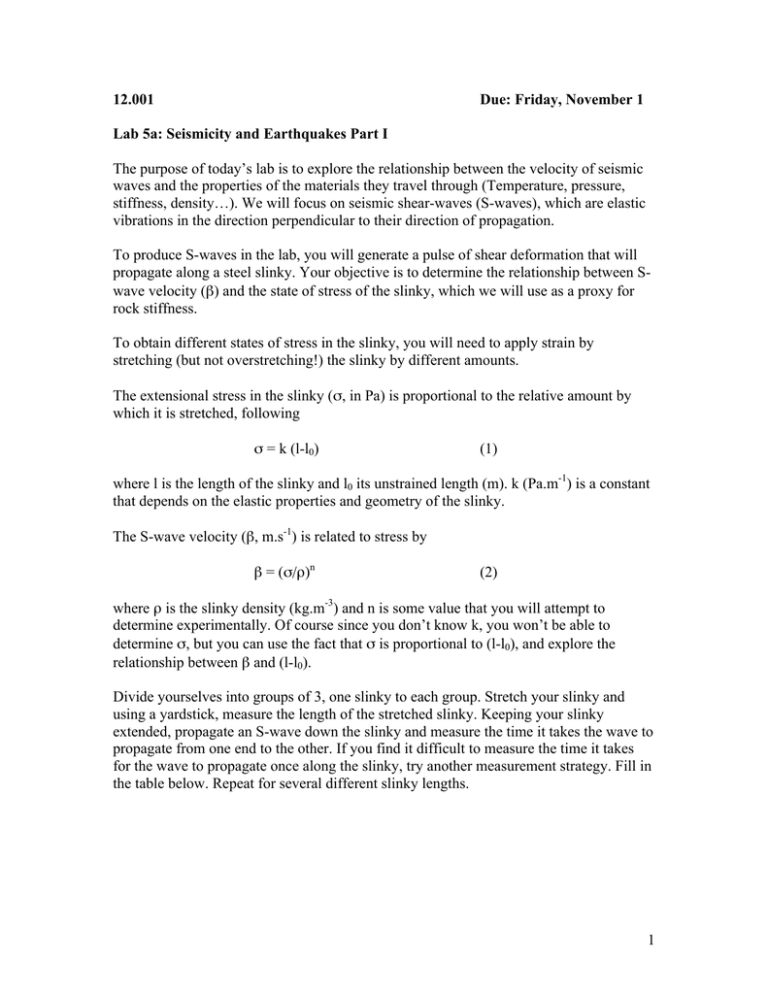
12.001 Due: Friday, November 1 Lab 5a: Seismicity and Earthquakes Part I The purpose of today’s lab is to explore the relationship between the velocity of seismic waves and the properties of the materials they travel through (Temperature, pressure, stiffness, density…). We will focus on seismic shear-waves (S-waves), which are elastic vibrations in the direction perpendicular to their direction of propagation. To produce S-waves in the lab, you will generate a pulse of shear deformation that will propagate along a steel slinky. Your objective is to determine the relationship between Swave velocity (β) and the state of stress of the slinky, which we will use as a proxy for rock stiffness. To obtain different states of stress in the slinky, you will need to apply strain by stretching (but not overstretching!) the slinky by different amounts. The extensional stress in the slinky (σ, in Pa) is proportional to the relative amount by which it is stretched, following σ = k (l-l0) (1) where l is the length of the slinky and l0 its unstrained length (m). k (Pa.m-1) is a constant that depends on the elastic properties and geometry of the slinky. The S-wave velocity (β, m.s-1) is related to stress by β = (σ/ρ)n (2) where ρ is the slinky density (kg.m-3) and n is some value that you will attempt to determine experimentally. Of course since you don’t know k, you won’t be able to determine σ, but you can use the fact that σ is proportional to (l-l0), and explore the relationship between β and (l-l0). Divide yourselves into groups of 3, one slinky to each group. Stretch your slinky and using a yardstick, measure the length of the stretched slinky. Keeping your slinky extended, propagate an S-wave down the slinky and measure the time it takes the wave to propagate from one end to the other. If you find it difficult to measure the time it takes for the wave to propagate once along the slinky, try another measurement strategy. Fill in the table below. Repeat for several different slinky lengths. 1 Length l (m) l-l0 (m) travel time (s) Distance traveled (m) Wave velocity (m.s-1) 2 Questions: 1a) How does the wave velocity change with the stress state of the slinky? Does the relationship appear linear (i.e., n=1)? Determine the value of n that best fits your data. Draw a plot to illustrate your answer. Check whether your value of n makes sense using dimensional analysis on equation (2). b) Now determine the value of k, given that the density of steel is ρ=7800 kg.m-3 c) This is not a perfect experiment, and your results may deviate from the equation you get out of the dimensional analysis. Briefly explain why your results are not perfect. 2) In the real Earth, it is the rock’s elastic (shear) modulus µ (in Pa) rather than the state of stress σ that controls S-wave velocity following β = (µ/ρ)n (3) a) How does rock density change with depth (i.e. pressure) in the mantle? How should this affect S-wave velocity? b) It is well established that shear wave velocity increases with depth in the Earth. What does this tell you about the evolution of the shear modulus of rocks with increasing pressure? 3) The shear modulus of a material is not only pressure dependent but also temperature dependent. Do you predict the sign of this relationship to be positive or negative? How will this change the velocity of S-waves? 4) The Shear modulus describes a material’s response to shearing strains. We’ve learned previously that liquids cannot be sheared and thus have shear modulus equal to zero. Earth Scientists have employed this phenomenon to learn more about the Earth and its structure. Describe one such application. 5) Attached to your lab you will find recent Shear wave velocity measurements at several depths beneath the Hawaiian Islands (Wolfe et al., 2009). You’ve learned in class that Hawaii is a ‘hot spot’ type environment. You’ve also learned in class that this is a highly debated topic. Based on the temperature and pressure dependence of shear wave velocity, what can you conclude based on the data? 3 MIT OpenCourseWare http://ocw.mit.edu 12.001 Introduction to Geology Fall 2013 For information about citing these materials or our Terms of Use, visit: http://ocw.mit.edu/terms.
